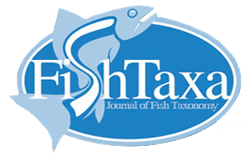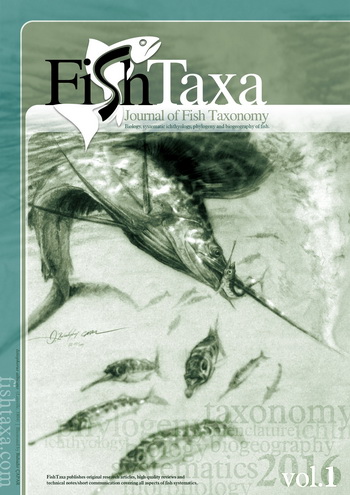Submissions
Online Submissions
Already have a Username/Password for FishTaxa?
Author Guidelines
Submissions are only electronic via online submission system.
The submitted manuscript should have the following sections:
1. Title Page
The title page should include:
Manuscript title
The name(s) of the author(s)
Address(es) of the author(s)
The e-mail address and telephone number of the corresponding author
Running title
Suggested reviewers
2. Abstract
150-400 words. Please do not put P-value, abbreviations or any reference.
3. Keywords
4-5 keywords.
4. Manuscript
Manuscripts should be submitted in MS-Word (preferably in .docx format) with the font Times New Roman (size 12 pt).
The manuscript should have: Introduction, Materials and Methods, Results, Discussion, Acknowledgement (if any).
Scientific names should be italic. Pages should be numbered. All lines should be numbered automatically using the MS-Word.
5. References
Citation in the text
Examples:
(Dumont 1998).
Dumont (1998).
Smith and Johnson (2011).
(Smith and Johnson 2011)
For 3 or more than 3 authors:
(Anan et al. 2002)
Anan et al. (2002)
Separate authors in a parenthesis using;
(Kajiwara et al. 2003; Weißflog et al. 1999; Korshenko and Gul 2005)
All references cited in the text should be quoted in this section. Journal names should be expanded. Please do not insert abbreviations. For example, expand J. Fish. Biol. to Journal of Fish Biology Provide Digital Object Identifier (doi) for articles wherever available.
Reference list at the end of the paper
Journals
Agusa T., Kunito T., Tanabe S., Pourkazemi M., Aubrey D.G. 2004. Concentrations of trace elements in muscle of sturgeons in the Caspian Sea. Marine Pollution Bulletin 49: 789-800.
Book
Townsend C.R., Begon M., Harper J.L. 2003. Essentials of ecology, 2nd. Blackwell Science publishing. 530 p.
Cooke G.D., Welch E.B., Peterson S.A., Nichols S.A. 2005. Restoration and management of lakes and reservoirs. CRC Press. Florida, 591 p.
Book Section
Coutteau P. 1996. Micro-algae. In: P. Lavens, P. Sorgeloos (Eds.). Manual on the production and use of live food for aquaculture, FAO Fisheries Technical Paper. No. 361. Rome, FAO. pp: 7-47.
Conference Paper
Cellario C., George S. 1990. Second generation of Paracentrotus lividus reared in the laboratory: Egg quality tested. In: C.d. Ridder, P. Dubois, M.C. Lahaye, M. Jangoux (Ed.). Echinoderm research: proceedings of the second European conference on Echinoderms. Brussels, Belgium, Balkema, Rotterdam. pp: 65-70.
Thesis
Clarke M. 2002. The effect of salinity on distribution, reproduction and feeding of the starfish Coscinasterias muricata (Echinodermata: Asteroidea) in a rocky subtidal community of a New Zealand fiord. M.Sc. thesis, Department of Marine Science, University of Otago. 84 p.
Webpage
Wray G.A. 1994. Echinodermata. Available from: www.tolweb.org. Retrieved 3/19/2004.
6. Tables
Tables should be numbered and cited in the text, for example: Table 1. All tables should have a caption above the table ending to a “.”. All tables should be inserted at the end on main text. The authors can indicate the insertion place of tables in the text by putting the table’s number in the bracket, for example [Table 1].
Tables must be self-explanatory, contain synthesized data, and not exceed A4 size. Data shown on graphs should not be repeated in tables and vice versa.
7. Graphs and Illustration
All graphs and illustrations should have a caption below the table ending to a “.”
Graphs and illustrations should be cited in the text, for example: (Fig. 1).
The font of the graphs or any text on the illustrations should be Times New Roman. Size of the text on graphs and illustrations should be 10 pt.
Submitted manuscripts should have graphs and illustrations shoud be inserted at the end of the text after tables. Graphs and illustrations can be submitted separately. If illustrations are going to be submitted separately, prepare them with the following format (with a resolution no less than 300 dpi) and determine their locations in the paper:
For vector graphics, EPS
For halftones, TIFF format.
The resolution of photographs must be 300 dpi at print size (original extension: jpg or tif).
Line art pictures (tif extension) must be done electronically (not scanned) and their resolution must be 600 dpi at print size.
The authors can indicate the insertion place of figures in the text by putting the figures’ number in the bracket, for example [Figure 1].
Colour illustrations will be published free of charge only in the electronic version of the journal (pdf files).
8. Copy Right
With submitting a paper to the FishTaxa, you accept to transfer automatically the copy right to the FishTaxa. Submitting a paper to the FishTaxa means that all authors have seen the paper and agree with the final form of the submitted paper and their positions in the author list. No part of the submitted paper should be published before.
9. Suggestion of potential reviewers
Authors are encouraged to suggest three potential reviewers for their paper.
10.Technical notes/ Short communication
Technical notes/Short communication has similar guidelines to original articles (above mentioned Author Guidelines) but its page number should be limited to 3-4 with a merged results and discussion.
11. New description of fish species
For description of new fish species, all new descriptions must follow the guidelines provided by the International Commission on Zoological Nomenclature (ICZN).
Latin abbreviations such as gen. nov., sp. nov., ssp. nov., syn. nov., and comb. nov. must follow new taxa, synonymies or new combinations.
The complete data of the types, name bearing (e.g., holotype, lectotype, syntype) or otherwise (e.g., paratypes, topotypes), and the name of the depository should be provided in the original description.
Type material should contain the following details: registration number, sex, date of collection, exact name of the site of collection, broader area name, District/Province/State, Country, latitude longitude information of the site of collection, and collector’s name. Manuscript will not be accepted if the registration numbers and name of the depository are not mentioned.
For example: Holotype: GUIC CC1462MA; 68.4 mm SL, Iran, Hamedan prov., Gamasiab River at Dehno, a tributary to Karkheh, 34°10’15″N, 48°21’19″E, altitude 1610 m, 20 September 2011, S. Vatandoust, H. Mousavi-Sabet. Paratypes: GUIC CC1462M; 6, 65.2–98.2 mm SL; same data as holotype; FSJF 3225; 18, 26–37 mm SL, Iran, Hamedan prov., Gamasiab River south of Habibabad, a tributary to Karkheh, 34°16’54” N, 48°09’26″E.
Submission Preparation Checklist
As part of the submission process, authors are required to check off their submission’s compliance with all of the following items, and submissions may be returned to authors that do not adhere to these guidelines.
- The submission has not been previously published, nor is it before another journal for consideration (or an explanation has been provided in Comments to the Editor).
- The submission file is in OpenOffice or Microsoft Word document file format.
- The text adheres to the stylistic and bibliographic requirements outlined in the Author Guidelines, which is found in About the Journal.
- Confirm that all the research meets the ethical guidelines, including adherence to the legal requirements of the study country. Meanwhile, the contents of this manuscript have not been copyrighted or published previously.
- Confirm that all authors of the paper have read and approved the final version submitted.
Privacy Statement
The names and email addresses entered in this journal site will be used exclusively for the stated purposes of this journal and will not be made available for any other purpose or to any other party.

